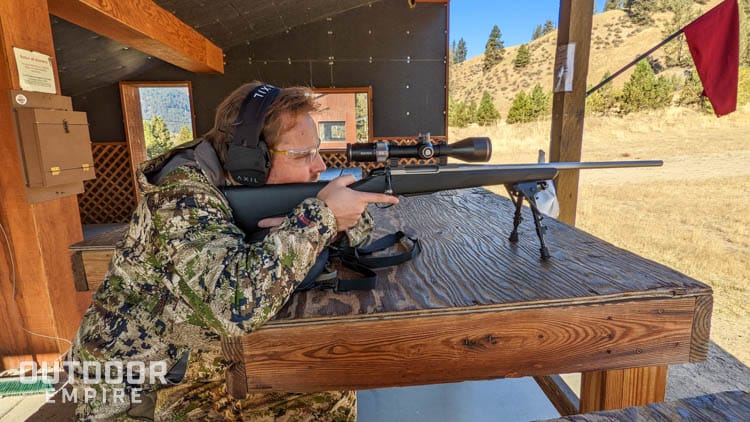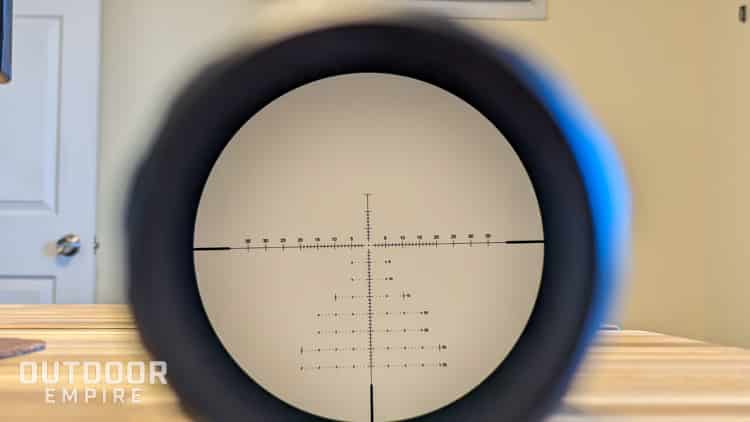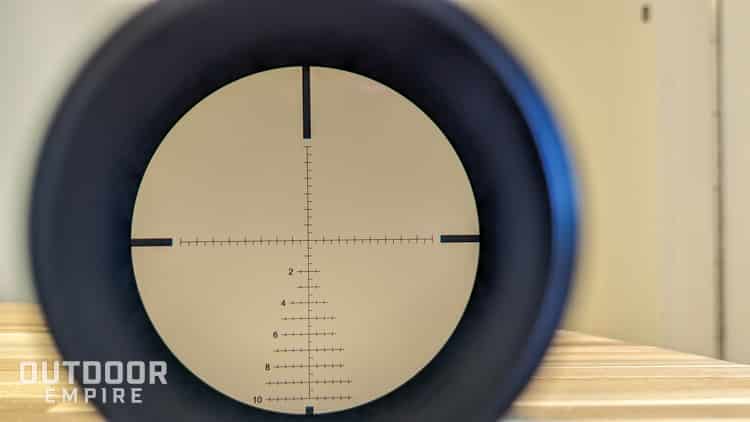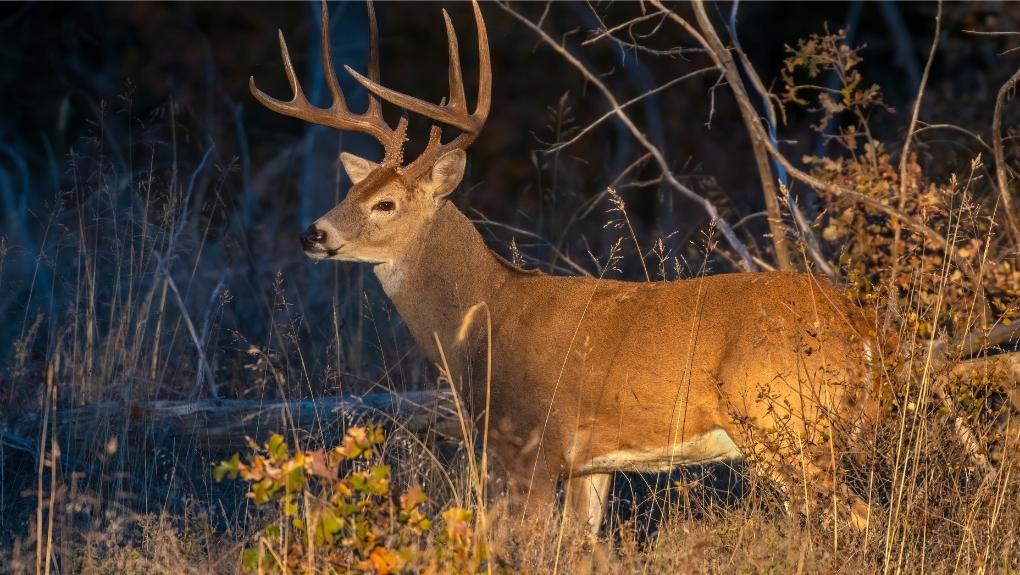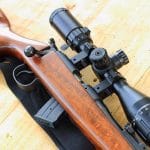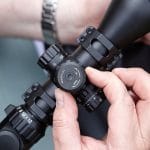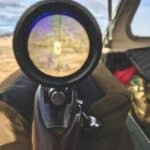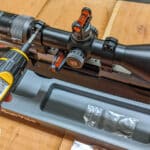Whether you forgot your rangefinder at home, it broke in the field, or you want to learn how to find the distance to target without a rangefinder accurately, hunters sometimes use their scope to determine how far away a target is.
The question most often asked is: Can you accurately use a scope to range a target?
You CAN use only your scope to accurately range a target. Scopes usually have MOA or MRAD markings which are units of measurement that represent angle. Using a formula, hunters can place accurate shots on target out to 800 yards by plugging in the target size in inches and the target size in MOA or MRAD, depending on your scope.
This article covers how to accurately range your target with your scope and a few factors you should consider when using this method of determining distance.
Why Range Finding is Important
No matter what weapon system you use when hunting, gravity strongly affects the bullet trajectory.
Even the beloved, flat shooting 6.5 Creedmoor drops nearly 55 inches at 500 yards.
For hunters who don’t know how to or can’t determine the distance to target, this can mean missing the game entirely or nonfatally wounding an animal, causing unnecessary pain and suffering.
I’ve seen hunters guess at the distance to target or not factor it in, causing them to shoot both high and low, and miss a big trophy game at distances from 200-600 yards. To avoid this, hunters can purchase a rangefinder, use their scope, or use other methods
Related: How to Range Without a Rangefinder
How to Calculate Distance with Your Scope
Using your scope to determine the distance to target requires some simple math and a good scope. A good scope has hash marks (MOA/MRAD) etched into it, which allow you to range your target accurately.
Using this information and the height of your target, you can quickly come up with a solution that gives you a close approximation of distance and what your holdover should be.
The Formula
There are two formulas used to determine distance through the scope.
The first is the MOA (Minute of Angle) Formula:
Target Size (Inches) X 95.5
______________________ = Distance to Target
Target Size in MOA
The second is the MRAD (Milliradian) Formula:
Target Size(Inches) X 27.77
______________________ = Distance to Target
Target Size in MRAD
Here are two examples of the equation.
How to Range with an MOA Scope
16 inches is a good size from backbone to belly on a Whitetail where I come from. Through your scope, that area is covered by 5 MOA marks because of the reticle.
Your equation should go as follows:
(16×95.5)
________ = ?
5
If you’ve done your calculations correctly, the distance to the target should be about 305.6 yards.
How to Range with an MIL Scope
For the same animal, let’s use the MRAD formula.
The deer measures 16 inches from belly to backbone and covers 1.5 Mil in your scope reticle.
(16×27.77)
_________ = ?
1.5
If you did your math, it chalks up to about 296.21 yards.
Personal Experience
I used the MOA formula when shooting a large Whitetail in Mississippi with a Remington .30-06 at about 106 yards.
Alone at 7:00 am on a chilly December morning with the wind so cold I regretted not wearing a second pair of long johns, I heard the unmistakable thundering of hooves over the chattering of my teeth.
Buck fever took over, and as the deer rushed past my ground blind on the side of a dike overlooking the farm pond, I took point-blank aim, squeezed the trigger, and missed…twice.
Cursing myself for letting adrenaline get the best of me, I watched in shock as the deer sprinted to the levee’s end and slowed to a walk after hitting the food plot to my left. Whether he thought it was thunder or was just not as intellectually gifted as another whitetail, I’m not one to look a gift horse in the mouth.
He was a big one. 16 inches was my guess, and it covered over 12 MOA. ( I shouldn’t have needed the formula at this distance, but I wanted to confirm my shot.)
I did the quick math ( I was a lot better at mental arithmetic back then), put the reticle behind his right shoulder, slightly higher than the center, and fired.
He dropped like he had been struck by lightning. I ran over, saw that he was still breathing, and put a security round in him to finish the job.
Had I not used the equation, I probably could have made the shot. But using that method definitely helped me put my bullet where it needed to go and gave me the confidence I lacked from my two previous misses.
Accurately Estimating Animal Size
Estimating the size of an animal can be difficult, and it can have major implications on your shot if guessed incorrectly.
Plenty of outdoor publications provide general ballpark size estimates for various species of big game. It’s also recommended that you check your local fish and game website, which often provides an accurate list of sizes compiled by biologists to help you guess.
However, the two most accurate ways to determine an animal’s size are practice and recording the size of the game you’ve killed.
You can practice by guessing at objects in your backyard, in the woods, or on the street and then measuring them to determine how far off you were. With a bit of practice, you can get your approximations pretty close, allowing you to make an educated guess out in the field.
Recording the size of the game you killed can give you an idea of what to expect from other game in the region. If your area is known for trophy Whitetail or Mulies, a fluctuation of an inch up or down depending on how the deer looks is not a bad idea.
You may be asking yourself, does an inch make a major difference when shooting at a distance?
The answer is more surprising than you might think. For instance, let’s say you’re taking a shot at a deer that covers 4 MOA. The deer is 16 inches, but you guess 17.
(17×95.5)
________ = A little over 400 yards
4 MOA
Not a bad shot.
Let’s look at the difference using the actual size of 16 inches.
(16×95.5)
________ = 386yards
4 MOA
Close distances will cause you to be off between 10-20 yards, but at 2.5 MOA, that’s over a 40-yard difference.
That’s why it’s essential to guess sizes accurately when calculating distance with your scope.
A Good Scope
While sticking to a budget is essential, don’t be cheap. Buy a good scope. Investing in a critical piece of hardware like a riflescope can help you accurately range your targets.
While hunters go back and forth on the pros and cons of MRAD vs. MOA, it’s more important to invest in a scope that works best for you.
If you find you can do the math better with one or like how it looks through the scope better, stick with that one.
When purchasing a scope you may use to range targets, it’s important to factor in three things:
- Scope clarity
- Hash mark definition
- Scope power
There are plenty of quality scopes at an affordable price, but don’t let the price tag be your deciding factor. Vortex, Nightforce, Leupold, and Zeiss all make quality scopes in a wide price range.
Wind
Many people think the wind is something you lick your finger for, feel the breeze, and can tell which way the wind is blowing. Most hunters don’t consider that the wind can be different from your position at the target with longer shots.
This problem can be solved with a high-end laser range finder and/or a ballistic calculator. Or you could just get closer to the animal; your choice.
Get a Rangefinder
Before delving into using your scope to determine the range, hunters must note that this method is an approximation and not exact science.
Using a rangefinder, you can determine the target’s precise distance without doing extra math or guessing at a target size.
Recommended: Best Rangefinders for Hunting
If money is an issue, budget rangefinders start at a little over $100 and are easily stowed in a pack or jacket during a backcountry hunt. These lightweight pieces of gear are worth their weight in gold, so serious hunters should look into purchasing one before heading out into the woods or backcountry in pursuit of big game.
Conclusion
Hunters can accurately range prey using a scope and some simple math. However, it should be noted that this does involve some guessing and the distance is often a close approximation.
If you’re like me and don’t want to pull out the phone or scratch paper, invest in a good rangefinder and save yourself a headache while getting an accurate distance on your next big game trophy.

